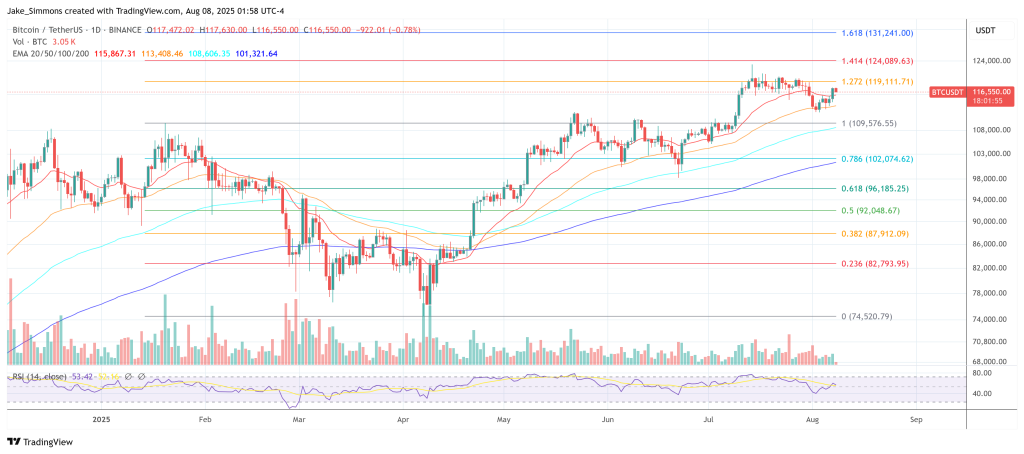Bitcoin took a symbolic step into the US central financial institution on Thursday as President Donald Trump nominated Dr. Stephen Miran, the White House Council of Economic Advisers chair, to fill a vacant seat on the Federal Reserve Board of Governors by January 31, 2026, pending Senate affirmation. The short-term appointment follows the early resignation of Governor Adriana Kugler and provides the White House a right away voice on the Board whereas a longer-run personnel shuffle—most notably the query of who succeeds Chair Jerome Powell when his chairmanship ends on May 15, 2026—continues to loom.
Miran’s résumé straddles markets and coverage. Before turning into CEA chair, he served at Treasury through the pandemic and labored in macro investing; he has since revealed work proposing to overtake Fed governance—arguing the central financial institution has drifted into “groupthink” and “extreme financial lodging.” In a 2024 Manhattan Institute report he and coauthors urged shorter Board phrases, clarified presidential elimination authority, extra energy for the Reserve Banks, and bringing the Fed’s funds below congressional appropriations—modifications they are saying would ship “higher financial outcomes” whereas restoring democratic accountability.
Markets and macro watchers instantly tried to triangulate what Miran’s arrival means for the near-term coverage combine. The sensible impression could possibly be bounded by the calendar—his time period runs solely by January 31, 2026, masking a handful of FOMC conferences—however the symbolism is just not: the nomination lands because the White House has pressed for charge cuts and previewed a broader reshaping of the Fed after Powell’s time period as chair ends subsequent May. Miran is a like-minded voice now whereas the administration canvasses candidates for the chair.
Miran has been an outspoken critic of the Fed’s pandemic-era stance and its later framework pivot; the Manhattan Institute paper faults the central financial institution’s “extreme financial lodging” and its dismissal of early inflation as “transitory.” He has additionally argued, in interviews and coverage essays, for rebalancing the worldwide financial system and for tariffs as a instrument to shift burden-sharing with out intentionally weakening the greenback—positions that put him squarely inside the present administration’s macro playbook.
‘Bitcoin Fixes This’ – Miran
Bitcoin circles seized on the appointment for a unique purpose: Miran has, on a number of events, echoed a preferred Bitcoin chorus. On Aug. 18, 2023, he posted “Bitcoin fixes this” from his private account, and social-media archivists circulated a separate Jan. 9, 2022 occasion of him writing “Bitcoin fixes this.”
That posture tracks with remarks Miran made in late 2024 concerning the function of economic deregulation—in addition to Bitcoin and crypto particularly—in a progress agenda. In a December 2024 interview on The Bitcoin Layer, he mentioned: “Financial deregulation goes to be a strong a part of that. I believe that crypto has a giant function probably to play in innovation.” (The dialog is broadly excerpted and summarized in crypto commerce protection.)
Reaction throughout X was swift. MacroScope referred to as the choose “Huge. I’ve posted about Miran earlier than. Always been a fan.” Steven Lubka, the Vice President of Investor Relations at Nakamoto, highlighted the archival Bitcoin posts: “A future member of the Federal Reserve board has tweeted ‘Bitcoin Fixes This’”. Alex Gladstein of the Human Rights Foundation, a distinguished Bitcoin advocate and Fed skeptic, merely wrote: “Strange instances.”
Beyond the headline Bitcoin angle, Miran’s publication file suggests he’ll push internally on two axes: governance and scope. In a Mercatus Center dialogue final yr, he criticized large-scale asset purchases for eroding the road between fiscal and financial coverage, a theme echoed in his Manhattan Institute report’s name to “cordon off” non-monetary features from the FOMC and to revive a narrower, technocratic give attention to worth stability. Those proposals—shortening Board phrases, clarifying presidential elimination, strengthening Reserve Banks, and subjecting the Fed’s working funds to appropriations—would collectively quantity to probably the most consequential redesign of the Fed’s institutional structure in many years.
For now, the sensible timeline is simple. The seat Miran would occupy is the rest of Kugler’s time period ending January 31, 2026; affirmation is required, and the calendar means he could possibly be seated for only some conferences earlier than the following inflection level in Fed management. Powell’s time period as chair ends May 15, 2026, although his underlying Board tenure runs to January 31, 2028, and presidents traditionally sign chair selections months prematurely. Today’s interim transfer, subsequently, seems much less like a capstone than the primary placement in a bigger chess sport over the central financial institution’s route into 2026.
At press time, Bitcoin traded at $116,550.

Featured picture created with DALL.E, chart from TradingView.com

Editorial Process for bitcoinist is centered on delivering completely researched, correct, and unbiased content material. We uphold strict sourcing requirements, and every web page undergoes diligent evaluate by our workforce of high expertise specialists and seasoned editors. This course of ensures the integrity, relevance, and worth of our content material for our readers.









